Hawaiian OIBS
Tholeiites, Picrites and Alkali Basalt Series
The Hawaiian islands, like most within the great ocean basins, are entirely volcanic; unlike many they are mainly built of tholeiitic basalt-picrite series, all showing the classic flat or slightly domed mantle or E-type MORB-normalised fingerprints of all igneous rock derived from the sub-oceanic mantle. The Hawaiian rocks are more enriched in the residual elements than are most MORBs being about average EMORB in composition and almost transitional to alkaline rocks.
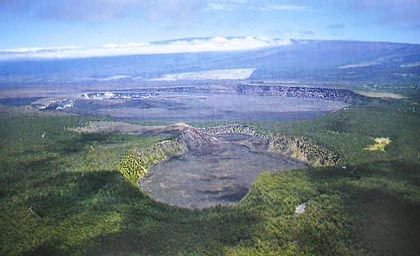 Kilauea Caldera with Kilauea Iki (1959) lava lake in an old pit crater
Kilauea Caldera with Kilauea Iki (1959) lava lake in an old pit crater
in foreground. The vent can be seen on the far left of the lava lake.
Within Kilauea Caldera is the Halemaumau fire pit (far middle left).
The buildings on the left make up the volcanological observatory.
Mauna Loa in far distance.
|
Links within this page:
|
Most oceanic islands originate on or near spreading centres and often form chains of islands trending at right angles away from the oceanic ridges. Hawaii is unusual in that it is a persistently active centre located away from the spreading oceanic ridges, and is one of the quite rare "Intra-plate" centres, along with Reunion Id. in the Indian Ocean. It is postulated that these are located over a persistent deep seated heat source or "Hot Spot" from which a "plume" of hotter rock continually rises towards the surface.
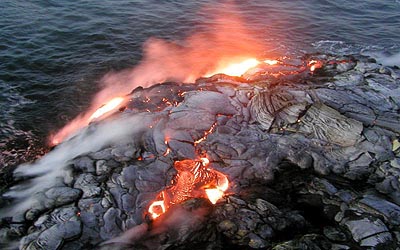
New outfall to sea, Pu'u O'o, 2001
(USGS, Hawaiian Vol. Observatory)
|
With the exception of some of the Galapagos Islands, tholeiitic island centres are invariably enriched in LILE elements, Cs, Rb, Ba, Nb, K, & light REE relative to NMORB rocks. Even the Galapagos are enriched compared to the local Galapagos Rise which is in part formed of some of the most depleted N-Morbs known.
The Islands of Hawaii
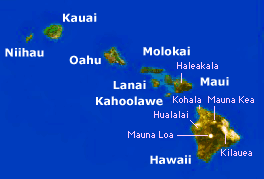 The Hawaiian group of volcanic islands are perhaps the best known world-wide for their spectacular scenery and their active volcanoes which are however confined to The Big Island (Hawaii) at the south-eastern end of the chain. The latter is about 100 miles across with the two largest volcanoes Mauna Loa and the extinct Mauna Kea towering (if a hill with a gradient never greater than about 15 deg can be said to "tower") to about 13,000ft. Recent activity is confined to Mauna Loa, the parasitic shield Kilauea, and an offshore seamount, Loihi. The Pu'u O'o vent on the Kilauean East Rift Zone has now (Aug. 2004) been erupting continuously for 21 years. The Hawaiian group of volcanic islands are perhaps the best known world-wide for their spectacular scenery and their active volcanoes which are however confined to The Big Island (Hawaii) at the south-eastern end of the chain. The latter is about 100 miles across with the two largest volcanoes Mauna Loa and the extinct Mauna Kea towering (if a hill with a gradient never greater than about 15 deg can be said to "tower") to about 13,000ft. Recent activity is confined to Mauna Loa, the parasitic shield Kilauea, and an offshore seamount, Loihi. The Pu'u O'o vent on the Kilauean East Rift Zone has now (Aug. 2004) been erupting continuously for 21 years.
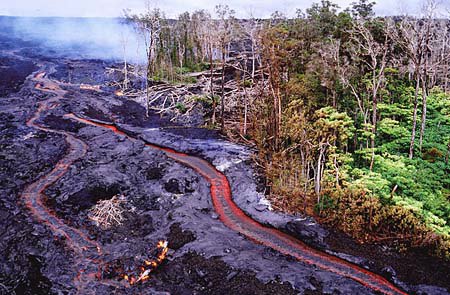 Lava stream deepening it's channel by building levees on the banks
Lava stream deepening it's channel by building levees on the banks
and possibly by down-melting. In time it will roof over and form a tube.
(Photo: USGS)
|
Fifty miles north-west is the smaller and extinct island of Maui, and clustered about it, Kahoolawe, Lanai and Molokai. Then comes Oahu with the well known city Honolulu, and, sixty miles further NW, Kauai and Niihau. A string of atolls and seamounts extend another thousand miles north-west to Midway from which the Emperor Seamounts extend north to the the western Aleutian Trench..
The Hawaiian group were and are being, built of tholeiitic (quartz saturated) basalt of predominantly 6 - 9% MgO. Mauna Loa, Mauna Kea and Kilauea are notable for the frequent occurrence of picrites, studded with olivine and of 12-25% MgO and correspondingly high Cr, Co, Ni. Of OIB's, only Reunion in the Indian Ocean has similar abundant picrites, though minor examples are known in the Galapagos and from Iceland. As in the MORBs, fractionation in the tholeiites is mainly confined to Fe-Mg-Ti, any rocks with less than 4% MgO being quite rare as are true ferrobasalts, though a few reach 15.5% Fe2O3 + FeO.
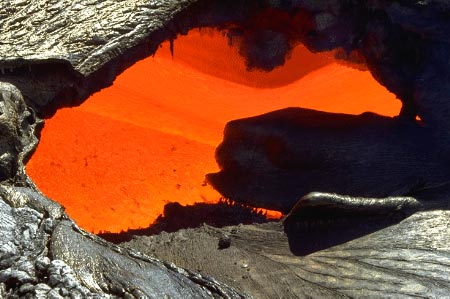 View through a skylight into a lava-tube conduit from Pu'u O'o.
View through a skylight into a lava-tube conduit from Pu'u O'o.
Note the "lavatites" hanging from the roof. (Photo: USGS)
|
On all islands the tholeiitic shield building stage persists for about 300,000yr. As activity slows over a lengthy period of perhaps another 100,000 yr, the composition becomes transitional to alkaline, Mauna Kea for example being capped by a series of adventitious cinder cones of Hawaiite. There follows a lengthy period of erosion lasting some tens of thousands of years when renewed activity (as on Maui especially) has produced "Rejuvenation Stage" basanites, alkali basalts, hawaiites, mugearites and some trachyte and phonolite. These constitute the only higher fractionates found.
 |
Variation Diagram for All Hawaiian data. >6000 samples. |
 |
Variation Diagram for All Hawaiian data. >7000 samples. |
As almost all samples of less than 5% MgO are from the alkaline members, it can be seen they have been paid more attention than their volume deserves. A curious bulge of higher P, Ti, Na, and Ca lying between 10-15% MgO is due to the inclusion of a series of late stage olivine melilite nephelinites from Moilili on the Koolau Range, Oahu, (Wilkinson et al, 1983, C.Min.Pet. 83, 363-74). Some of the alkali basalts can be seen to fractionate almost to the low-Al pantellerites. A horizontal spike of iron at 12% indicates the picrites which over most of the range oe of the same composition. Scattered high and low Fe at > 30% MgO are from harzburgite-wehrlite cumulate blocks. Fe and the other elements all converge toward olivine, such a pattern being most distinctive.
Much has been made of the differences in composition between the major centres, however one cannot type a volcano 30,000ft in height on a handful of samples collected from the last 120 years. In Kilauea even these show progressibe changes in time of TiO2 for example. Pu'u O'o has halved it's Nb in the 20+ years it has been eupting and become more tholeiitic. This MAY be due to source depletion. A range in Zr/Nb is seen in all the main shield-stage cones from about 10 to 14, but as few samples are glasses, some of this MAY be due to sample variation . However the HDSP drill hole in Manua Kea, which, being submarine were more glassy, also shows a range of 10 -14 in Zr/Nb and 32 - 45 in La/Lu. Mauna Loa is assumed to be the most depleted and tholeiitic but Rhodes found lavas very similar to Kilauea in the oldest Ninole Hills exposure. Overlap seem to be complete and had we sufficient samples spread over a wider range in time and of glasses, it is likely that the average composition of the main centres would be similar. Historic Kilauea has shown a regular variation of Zr/Nb of 8 - 13. Ba has also varied in parallel with a maximum in 1950.
Comparison of Hawaiian and Oceanic Ridge Basalts.
Hawaii is regarded as th type "Intraplate" basalt and is assumed to be compositionally different to the ORBs. There is SOME difference but it mainly lies in the fractionation paths, not in the basic composition. Like average ORBS, the tholeiitic Hawaiian basalts are only slightly more relatively enriched than chondrite with average La/Sm = 2 compared to 1.7 for chondrite. However bulk amounts of REE are about x12 chondrite. Most of the LILE elements overlap as they do with Iceland.
The main differences are:
(1) ORBS include very depleted high-degree melt NMORBS of La/Sm <1 and Zr/Nb > 28 not seen (as yet) in Hawaii.
(2) Hawaiian Tholeiites always have Sr > Zr > Y > Ba. In ORBS Sr APPEARS to be < Zr due to removal of Sr by early plag removal. In very magnesian ORBs Sr > Zr.
(3) Hawaiin tholeiites APPEAR to be more potassic especially on a Na - Mg - K ternary diagram. This is because in Hawaii higher fractionates belong to the more potassic alkali-basalt, basanite groups. In ORBs higher fractionates occur mainly in the larger volume lower degree-melt NMORBs and so are sodic. The only rhyolites we have data from are very sodic and derived from NMORbs. However, no Hawaiian rock has as low a K, Rb, Ba, Th as the very depleted NMORBs ( or DMORBs) otherwise the degree of overlap is high.
(4) The range in silica is the same in the more tholeiitic rocks, 48 - 52%. BUT the EMORBs have a silica range only slightly lower, usu 47 - 48%. In the alkaline rocks of Hawaii it is much lower, down to about 42-44%, confused by the presence of low-silica olivine cumulates. Why this is so is not positively known.
(5) As shown in the La/Nd diagram below, the plane of ORB parental melts (see ORB summary) also lies along the boundary of the alkaline members for the LILE elements, (Obviously not for silica) We cannot expand too far on this similarity because of scarcity of glasses from Hawaii. Comparison with the same diagram for ORBs shows it to be very simlilar except for the lack of extreme NMORB. (The low La members here are olivine cumulates).
(6) The greatest difference lies in the fractionation paths. In Hawaii olivine appears first at 8-10% MgO and continues until 7.5% MgO is reached when joined by cpx, and a little later at 7% MgO by plagioclase and by TiMt at 6%.
ORBs begin to crystallise plagioclase plus olivine at 10% MgO, with depletion in Al2O3 and Sr as well has MgO and elevation of other elements. At about 8% MgO this is joined by cpx. Why two magmas which may be of identical silca content and LILE composition should follow such different paths of evolution has never been explained, mainly because it is not commonly realised that this is so!
 |
La/Nd diagram for all Hawaii.
(including AOB, basanite etc) |
The plane of parental melts for ORBs is shown in blue. As in the ORBs it defines the bounday of the more al;kaline rocks.
Hawaii has an unexpectedly wide range of rare earths for an isolated volcanic island group. Tholeiite levels are low, Kilauea, Mauna Loa and Mauna Kean tholeiites have less than 20ppm La, 7ppm Sm. The very low members with <5ppm La are cumulate blocks. The rest belong to the late stage alkaline series. The most alkaline rocks have the highest La.
Iceland has almost the same distribution for these elements and also for Zr/Nb, in spite of their different tectonic situation. Iceland however, has few picrites but abundant ferrobasalt, icelandite and high Nb rhyolite sometimes derived from EMORB, never seen in Hawaii.
 |
Shield-building stage tholeiitic basalts and picrites
from all Hawaiian islands. All post shield, alkaline rocks have
been removed from the file as have all xenoliths, ankaramite blocks
etc.
Due to poor naming etc and inclusion of some old data, some oddities
may remain e.g. those samples showing very low P. Again, those of
less than 4% MgO are mainly SEM determinations of interstitial glasses.
Those of < 0.5% MgO are mainly from older rocks of Oahu, affinities
uncertain, they may be rhyodacites of the shield stage or intruded
trachytes from the post-shield stage. No TE or REE available for
these.
Note the quite wide spread of K and Ti as seen between Mauna Loa
and Kilauea, also seen in variation with time for Kilauea. The constancy
of the picrites from nearly a dozen centres and over an extended
time period is however remarkable.
This diagram includes data on the shield stages of Kilauea, Mauna
Loa, Mauna Kea, Hualalai, Kohala, and Lanai. |
 |
Metallic Elements for the Hawaiian Shields.
Dominated as usual by olivine accumulation, the trace metals show
a regular distribution with the exception of a group of high Zn,
which are NOT due to mineralisation but to the use of a galvanised
pipe to collect sample of hot magma from Puu Oo!
The rather wide band of Ni may suggest that degree of partial melt
is an influence here also. |
 |
The Alkaline Earth elements.
Zr has for the most part a lower level than Sr which is unusual
in basalts. |
 |
Averaged data of all Hawaiian Shield stage rocks
from all islands in the group. |
 |
Ternary FMA diagram of all all Hawaii and shield
lavas and picrites. Note the constancy of olivine composition. |
 |
The K2O level varies with the alkalinity of the magma. Some rocks included, eg from Kohala, are transitional. |
 |
|
Kilauea
Kilauea; a shield volcano on the eastern slopes of the 13,700ft Mauna Loa on the "Big Island" of Hawaii, is one of the most active centres in the world. It has had 24 eruptions since 1952 not including the current eruption of Pu'u O'o, which since 1983 has been almost continuously emitting lava. Kilauea is centred on a summit collapse caldera overlooked by the Kilauea Observatory, though the old inner Halemaumau Firepit has long since solidified. Historic activity has taken place either at the summit caldera or nearby as in the 1959-61 Kilauea Iki eruptions, or else either down the South-West Rift Zone or the East Rift Zone along which Pu'u O'o is situated.
 |
All Kilauea historic data. (Bishop Museum File) This probably the most complete file for this volcano, but unfortunately many dates are missing especially for the Pu'u O'o series.
Note: as explained below, the parental magmas may range from <7.5% to 9% though rare glasses of 17.5% MgO have been reported but cannot be confirmed. The dominant trends may be due to increase in degree of partial melt from left to right or to crystal fractionation taking place from right to left. All may however be modified by addition or removal of olivine and any point giving rise to scatter of points. Due to general small sample size olivine grains may only have to move inches relative to magma to strongly modify a rock. Note that at 5-6% MgO, olivine has been mainly added. Apart from this very little fractionation is evident. Rocks more magnesian than 10% MgO are usually cumulative picrites though there may be more magnesian parental magmas not yet discovered. Glass samples of 10 - 17.5 % MgO were found in samples dredged off the East Rift zone by D. Clague (pers.comm.) though glasses of > 10% MgO are very rare. |
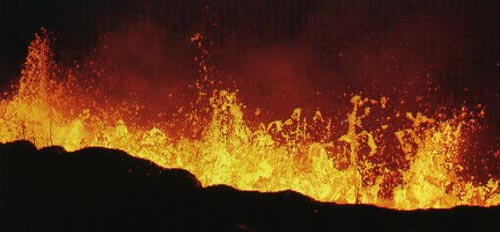
A typical rift eruption at night.
|
 |
Variation diagram for submarine samples from the seaward extention of the Kilauea Rift zone. Typical basalts - picrites extending more or less towards pure olivine. Data from D. Clague, (1991). |
 |
The 1959-60 Kilauea Iki eruption was one of the most spectacular ever. A vent opened along the edge of a small pit crater almost adjoining the Kilauea caldera. Lava heavily loaded with olivine frequently jetted to a height of 1000ft. There were some variations especially between 1959 and 1960, in the TiO2 and P2O5 content, but data of that era is not considered reliable as the USGS were experimenting with "quickie" analyses. Alumina especially is likely to be high. However, the paper by Murata and Richter (1966, USGSPP 527A, 1-26) was considered for many years to be the definitive paper on Hawaiian volcanism. |
 |
Variation Diagram for both 1955 Kilauea and the 1969-71 Mauna Ulu eruptions.
In 1955 a small eruption after several years quiescence yielded an unusually low MgO (5 - 7%) magma. It is similar both to 1959 Kilauea Iki and also to the 1969 - 71 Manua Ulu eruptions, the later being a vent a few miles down the east rift zone. The two together appear to show little variation from an olivine, then cpx, then cpx+plag fractionation series, but when TiO2 or P2O5 are inspected, Mauna Ulu shows two trends as shown below. No TE data available. |
 |
TiO2 / Mgo for Mauna Ulu and 1955 Kilauea. TiO2 levels reached a peak in about 1960-62 for Kilauea. However, lack of glasses and analytical uncertainties do not allow us to be positive, |
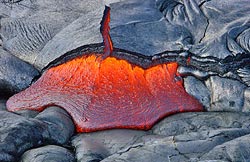
Lava pressure breaks through the thin skin of an advancing Pu'u O'o pahoehoe flow, very like the pillow rupture seen in submarine flows.
|
Pu'u O'o
Pu'u O'o is the name given to a vent on the East Rift Zone of Kilauea which has been erupting lava more-or-less continuously since 1983 averaging 7 cubic yards (5 cubic meters) per second. The lava composition became steadily more magnesian with time until about 1994 but since has been fairly constant. The content of Rb, Ba, K, Nb, K/Ti etc. has steadily diminished with time even when recalculated to a constant MgO content, (i.e. by subtracting olivine.) It seems as though the source is becoming depleted in the LILE elements or else the degree of partial melt of the mantle is increasing which would demand that the source be getting hotter. Though the total range of composition is not great, (from 5.5 - 10% MgO), it shows some interesting fractionation trends. An explanation offered by Thornber, (2003) is that the more magnesian members are the result of the intimate mixing of the original low MgO lava in a sub-crustal magma chamber, with a new, more magnesian and more depleted magma which is continuously flowing into it. This may be the case but as all of the shield volcanoes show about the same range of composition, it is rather more likely that composition changes somewhat with degree of melt.
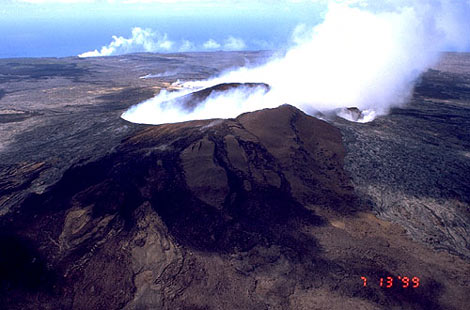
By 1999 Pu'u O'o has built itself a small shield cone around the vent.
As in Iceland a fissure eruption beginning along a rift may localised and become a
central volcano. A lava tube extends down to the coast where the steam is rising.
(Photo: USGS)
|
Pu’u O’O and Kupanaia 1983-2003 Eruption Characteristics
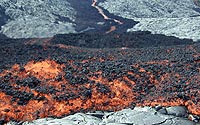
An advancing Flow front of blocky a'a
|
Pu’u O’o has been the longest recorded eruption in history, pouring out almost 2 km3 of magma in twenty years, trivial perhaps in comparison to others recorded in geological time, but very revealing petrogenetically. The lavas are glassy to slightly micro-vitrophyric. The lava appearing in 1983 of only 5.5% MgO to 7.5% MgO follows an Ol, Ol + Cpx, Ol+Cpx+Plag fractionation path. It has been suggested that this fractionated magma was trapped in the rift zone since the pre-Puu lavas of 1980-82 or even earlier. Since 1984 it has remained in the range 7.5 to 9.5% MgO, being in total of slightly greater than the range seen in primary melts in the ORBs with 6 – 10.2%. However as they are almost an exact replica of other historic Kilauean and Hawaiian series, we estimate that the possible range of primary unmodified magmas in Hawaii range from 7.5% MgO (the lower MgO lavas as seen in 1955 Kilauea being fractionates) to as high as 9% as seen in the most magnesian Pu'u O'o.
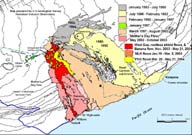 At 7.5% MgO, CaO reaches a maximum (see variation diagram), declining with both higher and lower MgO content. Al2O3 reaches a high point at about 6.2%. These are usually referred to as the “CPX IN” and “Plagioclase IN” points implying they are points on the line of crystal fractionation marking the control of first olivine (to the right) then Ol+Cpx, then Ol+Cpx+Plag. There is however apart from abundant picrites, a complete absence of plagioclase or clinopyroxene cumulates, where could have they gone? At 7.5% MgO, CaO reaches a maximum (see variation diagram), declining with both higher and lower MgO content. Al2O3 reaches a high point at about 6.2%. These are usually referred to as the “CPX IN” and “Plagioclase IN” points implying they are points on the line of crystal fractionation marking the control of first olivine (to the right) then Ol+Cpx, then Ol+Cpx+Plag. There is however apart from abundant picrites, a complete absence of plagioclase or clinopyroxene cumulates, where could have they gone?
Map by USGS>>>>
The "olivine only" sector from 7.5 to 9.5% MgO is NOT altogether an olivine fractionated series. When calculated to constant 7% MgO these samples still have become depleted in K, Rb, Ba, Th, U, Nb, Sr and a K/Ti trend heads for zero K at 1% TiO2 whereas the mineral olivine contains usually less than 0.02%. However as Kamenetsky (pers. comm.) has pointed out, olivine contains microblebs of entrapped lava which may modify the bulk composition.
Thornber et al (2003, USGS Prof. Paper) ascribe this trend of diversion from pure olivine to the mixing of two magmas, one of eutectic composition at 7.5% MgO and one more magnesian. Small scale variations are attributed to variations in the mixing of fresh, more basic magma, with the magma in a large magma chamber. However ALL hawaiian magmas show this same departure from an olivine cumulate trend as do Icelandic and ORB basalts, eg, all show the same trend toward K depleting faster than Ti, Nb faster than Zr, La faster than Sm etc. Olivine cumulate trends as seen in 1960 Kilauea Iki or 1967-71 Mauna Ulu, do however depart from the magnesian trend of Pu'u O', Kilauea, Mauna Loa, Mauna Kea etc at a distinct angle.
Comparison of Hawaiian Parental Melts with those of ORBs
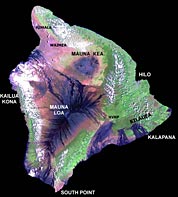 While ORBs and Hawaiian tholeiites have identical silica contents (51-2%), the general composition of the latter is on average more LILE enriched, almost transitional to alkali basalt, and roughly equates with standard EMORB. Nevertheless when the two series are compared there are some quite remarkable relationships. The Hawaiian series while LILE enriched compared to NMORBs, actually lie on the higher HFSE and lower LILE side of the ORB parents. When an LILE element from the “SM” series (of Sun & McDonnough) is plotted against an HFSE element, (eg, Rb against Y), the two series are both linear and project to an identical point on the HFSE axis. I do not believe this has been observed before. In general two elements close together on the “SM” series will converge close to the origin, eg Th/U, Ba/Rb, Ce/La, but there are exceptions, eg T/K and Ti/P converge to the same point at 1% TiO2. One percent TiO2 is the lowest level known in ORB basalts. While ORBs and Hawaiian tholeiites have identical silica contents (51-2%), the general composition of the latter is on average more LILE enriched, almost transitional to alkali basalt, and roughly equates with standard EMORB. Nevertheless when the two series are compared there are some quite remarkable relationships. The Hawaiian series while LILE enriched compared to NMORBs, actually lie on the higher HFSE and lower LILE side of the ORB parents. When an LILE element from the “SM” series (of Sun & McDonnough) is plotted against an HFSE element, (eg, Rb against Y), the two series are both linear and project to an identical point on the HFSE axis. I do not believe this has been observed before. In general two elements close together on the “SM” series will converge close to the origin, eg Th/U, Ba/Rb, Ce/La, but there are exceptions, eg T/K and Ti/P converge to the same point at 1% TiO2. One percent TiO2 is the lowest level known in ORB basalts.
| |____| |
La/Sm for both ORB parental melts (of Macquarie Id) and the Puu O’o range of Hawaiian parental melts. Notice both converge to a point at 2 ppm Sm and zero La. Neither trend toward the origin showing that neither are fractionated series ie their ratios La/Sm change continuously. |
| |____| |
Ti/K for both ORB and Hawaiian parental melts. Note that both converge towards zero K (or Cs, or Rb, or Ba, or Th) at 1% TiO2, Ba and Rb at even higher levels up to 1.5% TiO2. |
The composition from which these trends originates is that of a depleted NMORB (for minor and trace elements only) which must represent the most depleted melt that can be formed from the mantle. The different slopes of the series seems to suggest that the slope and compositions of lower degree partial melts are also governed by depth of creation, (pressure). This is at this point, conjecture.
Most descriptions of Kilauean compositional trends over the years have invoked fractional crustallisation, contamination and mixing of magmas. Shifts in composition between the high K, high Ti lavas of the 1960 - 65 era to the lower ti, K, Rb, etc of Pu'u O'o are probably real though there are uncertainties due to different analytical methods and analysts, eg USGS data show a difference of about 0.5% TiO2. My own data for TiO2 of 1960 by XRF compared to Pu'u O'o by XRF show them to be the same at the same MgO level.!!!
Summary
Whether the magnesian series of Pu'u O'o is formed of a mixing of two end members or whether they are a series of primary magma of increasing degree of melt cannot at this point be definitely proved or disproved. However if we accept that at least ONE higher degree melt, more magnesian parent can be formed, why not others?
 |
PuuOo, yr 84-98. Zr v Alkaline earths. Sr > Zr > Ba > Y > Nb > Rb. |
 |
PuuOo83-98- MgO v Metals. The high Zn samples are due to the galvanised pipe used in collection. Notice the narrow spread in V, quite unlike common OIB. |
 |
PuuOo- TiO2 v K2O. As neither Ti nor K is included in olivine, were this an olivine accumulation trend, the line would trend towards 0/ |
| |____| |
P2O5 / TiO2 for Pu’u O’o showing similarity of direction in the olivine-only sector (<2.5% TiO2). On line plots at the origin, a considerable divergence is seen. |
| |____| |
Zr/Ti vs days for P’u’O’o series. Except for 1983, only olivine microcrystallites are forming throughout yet Ti/K continue to increace, as do other HFSE/LILE pairs. However K2O/Rb and Ti/Rb appear to reach a maximum in about 1994. |
 |
Zr/Nb for Pu'u O'o between 1983 and 1998). Early fractionated rocks top right. The series curves towards the Zr axis with increacing depletion, becoming more tholeiitic. The tholeiite partial melt trend for this diagram runs almost vertically. However later data does not agree. The data of Thornber etal (2003) unfortunately do not include Nb. |
 |
Decrease in Nb with time, 1983-96, shown as days (0 - 3000). Vertical variation due to some minor olivine variation. |
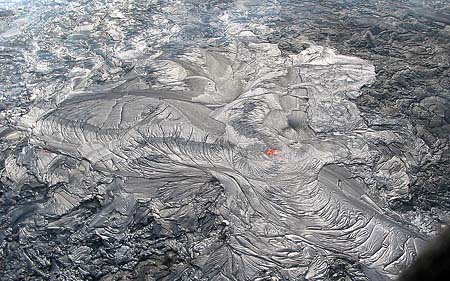 Lava shield Pu'u O'o. A small shield being built by overflow from a lava tunnel.
Lava shield Pu'u O'o. A small shield being built by overflow from a lava tunnel.
(Photo: USGS)
|
|
|
Kilauea. Range of composition change since 1984 during the Pu'u O'o eruption. Note it is about double that seen in 1994...
- The present composition of Pu'u O'o. With time the LILE have increased from late 18th century to early 20th, to flatten then decline from 1960-2000. The authors claim a maximum in 1920 approx coinciding with explosive activity at Halemaumau.
|
|
|
 |
MgO/Fe(t) for Pu'u O'o. The more magnesian samples trend towards an olivine more iron-rich than the usual Fo85 control usually seen in Kilauea. This is probably at least partly a partial melt trend towards a parental source including Ol-Cpx or Ol-Opx-Cpx mix as there is very little free olivine in the magmas. At 7.8% MgO the slope changes at an Ol-Cpx cotectic, (Cpx has a higher Fe/Mg ratio than olivine) and iron content drops to about 10.8%. At 6.5% MgO the Ol+Cpx+Plag eutectic is reached (at approx. 53% Plag, 32% Cpx and 15% Ol) and as the iron content of the crystal mix is much lower the iron in the residual magma begins to increase. These trends can be quite easily computer simulated and are seen in all basalts, though sometimes Ol is joined by Cpx with plag coming in later, or else all three appear together. Ocean ridge basalts may have plag appearing first, giving rise to the high-Al basalts or ol-plag joined later by cpx. |
 |
Here Ti (as well as other residual elements including Ba, Rb, K, Nb, Ti, P etc) increase quite regularly as iron decreases, until the Ol-Cpx-Plag eutectic is reached when iron increases again. Were these trends to continue, the Titanomagnetite point would be reached and there would be a sudden drop in both Fe and Ti (as well as V). |
Thanks are extended to Dr Mike Garcia in University of Hawaii for forwarding the Pu'u O'o data as it has become available over the years.
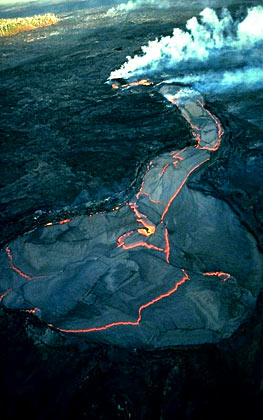
Kupanaia Vent in early 1990's.
Lava flows from the lava lake, down
the channel and into a lava tube.
|
Kilauean Historic Magmas
These include lavas from the summit caldera, the 1959 Kilauea Iki Pit and the South-west Rift Zone as well as the East Rift Zone. A high percentage are picrites with total range of 5-30% MgO but glasses without olivine phenocrysts are seldom seen with more than 10% MgO. At and below 7.5% MgO plagioclase and pyroxene also appear and the course of fractionation sharply changes (see below).
A very few rocks have reached the Titanomagnetite Point at 5% MgO and none reach the Apatite Point. This is exactly what is seen in the MORB rocks in spite of the fact that Kilauea, as well as Mauna Loa is much more potassic, Ti-rich and P rich than any MORB. The average Kilauean lava contains about double the REE of E-type MORB and treble the Rb and Ba. Compared to N-type MORB these figures can be doubled again, in fact Kilauea (in spite of being silica saturated) is very close in LILE content to the transitional oceanic alkaline rocks, such as seen in the Vestmanneyjar Islands off Iceland. Plots such as MgO/(Fe/Fe+Mg) for Kilauean Historic Magmas show the iron/magnesia curve is quite constant and projects towards an olivine of Fo85. There is no variation in this so that in the mantle, either Kilauean magmas are buffered against enormous amounts of Fo85 olivine, or the temperature of partial melting is remarkably uniform. Microprobe studies of Kilauean olivines show a wide range of composition sometimes as magnesian as about Fo90, but these are irrelevant to the petrogenesis of the magmas as the constant Mg/Fe curves show.
| |
CaO/MgO diagram showing abrupt shift in fractionation
trend between steadily decreasing MgO along the olivine control
line giving way to sudden CaO depletion with incoming of Cpx-Plag
at 7.5% MgO in Kilauea lavas. |
| |
Sharp increase in K2O at the Cpx-Plag
IN point and at the TiMt and Ap points for historic Kilauea. |
| |
|
|
|
CaO-TiO2 diagram showing increasing CaO
and Ti along the line of olivine control, giving way to decreasing
CaO but increasing Ti with Cpx-Plag-Ol control, giving way to a
drop in both Ti and CaO with the incoming of Titanomagnetite. The
fractionation trend describes a triangle. Some scatter due to mixing
of ponded olivine being mixed with new magmas. |
| |
MgO plotted against FeO*100/(FeO+MgO) for some reason
gives a much more regular curve than plain FeO/MgO. The FeO is taken
as 0.85 of the FeOT, as analysed Fe2O3 is highly variable. The 3
olivines at top left have been adjusted to FeO only. Olivines are
seldom analysed for Fe2O3 and if they are, it is vanishingly small.
One of these I admit, came from "green" beach sand, quicker
than separating from a picrite.
The constancy of this picrite curve is amazing. Below we see the
same curve for Mauna Kea – and it is exactly the same; as is
Mauna Loa. The curve can be computer simulated
by adding an olivine of Fo85.5 to an average undifferentiated basalt
of 7.5% MgO. So for millions of years Hawaii has been producing
olivines of the same composition. The picrites have rather more
than 12% FeOT, whereas supposed mantle has close to 8% FeOT, so
they are not mantle olivines which are about Fo92-94. Or do mantle
olivines partially melt to produce the Kilauean olivines?? |
| |
FeO*100/(FeO+MgO / MgO for Mauna
Kea. The group diverging at high FM index are the Laupahoehoe
hawaiites.
Note Fe/Mg trend is exactly the same as for Kilauea. |
Mauna Loa
Mauna Loa is 13,700ft high and represents the greatest volcanic edifice on earth. It forms a gently sloping dome which above sea level is 75 miles long and 31 miles wide. It has a total volume of 10,200 cubic miles of which 84% is below sea level. From 1843 to 1984 it averaged an eruption every 4.5 years. It is somewhat less active than Kilauea and is consistently more tholeiitic in character than either Kilauea or Mauna Kea, i.e., for a given MgO is has less, Cs, Rb, Ba, U, Th, K, P, Ti, Light REE etc.
 |
Submarine glasses from pillow lavas give an indication of the extent of possible primary magma and their posible olivine fractionates. Compare with Puu Oo. |
 |
Variation diagram for approx. 600 Mauna Loa picrites and basalts. Olivine fractionation dominates down to about 7% MgO where it is joined by plagioclase and clinopyroxene. |
 |
Metals distribution for Mauna Loa. |
 |
Zr vs alkaline earths, The scatter in Ba and higher Sr is suspect. Variation in other elements does not suggest it should be so high in Sr and Ba. |
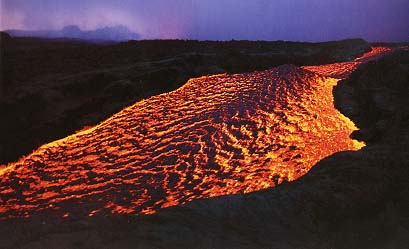
The 1984 Mauna Loa flow heads for Hilo!
(Photo: Glen Kaye)
|
A great deal of XRF data has also been produced for Mauna Loa, but much of it is unpublished.
|
|
Kilauea fingerprint (Pu'u O'o) normalised to EMORB.
Kilauea shows some shift in composition with time, eg, the 1959-60 Kilauea Iki appear to have been more titaniferous, but there is also some analytical uncertainty. |
Mauna Loa from submarine SW Rift Zone.
Note consistently lower LILE. The 1984 eruption, (Rhodes, 1988 ,JGR 93) is similar. |
 |
Variation diagram for rocks and minerals from Mauna Loa. Here we have a rather messy diagram for this volcano which provides an exercise in mineral identification,
The samples concentrated at 7.5% MgO and trailing off towards an olivine at about 47.5% MgO are basalts and picrites.
The linear group between 37-50% MgO and 8-24% FeOT are of course olivines. Note that the picrites show a flat trend at about 12% FeOT heading towards an olivine of about Fo85 and ignore variations in olivine composition.
Between 26-32% MgO are some picrites but the majority are orthopyroxenes. At 35% MgO is a picrite.
Clinopyroxenes lie between 16.5-22% MgO with high CaO and variable FeOT.
An odd group between 10-15% MgO with 19-30% FeOT are an unusually iron-rich aluminous spinel.
From 2.5 to 6% MgO are another odd group with higher alumina and CaO than the ordinary basalts but low Fe-Mg. These are included melt droplets in olivines of Mauna Loa picrites. The olivine seems to have gone on removing Fe-Mg allowing other elements to build up. They look at first glance like trachytes but K-Na remain low. They do not correspond to any normal rock. (Norman et al, 2002, Chem.Geol.183,143-168) My apologies to Marc Norman if I have not quoted him exactly.
The very low MgO, high Al-Ca-Na samples are of course plagioclases. Notice the absence of a ferro-basalt trend in Mauna Loa. |
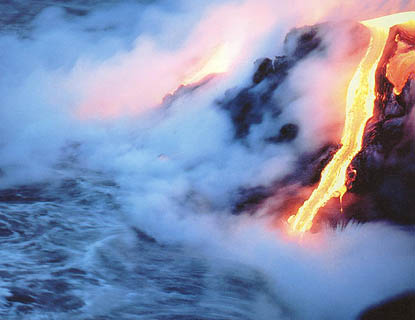
When lava flows into sea and chills it forms unstable steep cliffs.
When these slump, highly destructive tsunamis are formed.
Some waiting to happen might form waves over 500ft high!
Moral: don't live in a beach cottage round the Pacific.
On top of Mauna Loa it's cooler too!
|
Loihi
A new submarine cone has been found offshore to the south of Mauna Loa. The fingerprint of Loihi basalts, while appearing to differ in very minor detail is completely overlapped by Kilauea though some of the samples recovered are of a lower silica alkaline nature.
 |
Loihi, new submarine cone west of Kilauea. Note fingerprint is
identical to Pu'u O'o, slightly less enriched that the BHVO standard.
|
 |
Unusal fingerprints for Loihi tholeiites as above compared with Loihi picrites. Data from a special study on Hawaiian picrites, (Norman & Garcia, 1999, E.P.S.L. 168, 27-44). Even allowing for the dilution effects of an extra 10-30% olivine the HFSE of the picrites are very low. The increase in slope of Rb/Lu (or La/Sm etc) as well as a SiO2/Alk plot shows the picrites to be actually more alkaline than the more enriched tholeiites.
The Zr/Nb of 8.9 for Loihi compared with about 12 for Kilauea also suggests Loihi to be the more alkaline and very close to the alkali basalts-hawaiites-mugearites of the Westmanneyjar (Iceland), with Zr/Nb of 8.8. |
 |
Loihi shows the typical Hawaiian picrite series. However, notice the numerous alkali-basalt members shown by their high alumina. The Zr/Nb also ranges from 13 (tholeiite) down to as low as 5, (alkaline). Th/U shows a very regular trend at Th/U = 3.36, with an odd upturn in U in the higher members. This MAY be alteration but appears too regular. La/Sm increases with alkalinity from 2 to 4 and La/Lu even more so. |
Mauna Kea
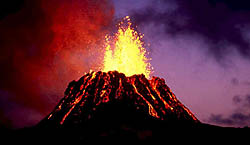 Fountain-playing hornito.
Fountain-playing hornito.
Photo: Urlich
|
This 13,800ft extinct cone is more symmetrical than Mauna Loa (not being elongated along rift zones) but appears as an inverted pudding basin. It is mainly tholeiitic except for a superficial cover of post-shield late-stage hawaiites but lacking deep erosion the main data for tholeiites come from submarine samples and from the recent HSDP drill core put down by the USGS.
The summit is surmounted by a series of small younger alkali basalt-hawaiite cones which chemically show the same shape fingerprint as Kilauea but being hawaiites are more LILE-enriched.
 |
For some reason the ratio of Nb to a heavy REE may sometimes be similar in different lineages. Here we show the difference between Mauna Kea (+,x), and the E.Pac. Rise with the Neo-Volcanic Zone of Iceland represented by Krafla, (Nicholson, 1992) in between. |
 |
La/Sm ratios for Mauna Kea and the Galapagos Rise. Data from the HDSP drill core (Yang et al,1996, J.G.R), the Hamakua and Maulua lavas, Mauna Kea (Frey, F., Garcia, M. et al, 1991, JVGR 96); the E.P.R. at 10deg 30'N, (Regelous et al (1999); Niu, Y. and Batiza, R. (1997, EPSL 148, 147-483). |
The recent HDSP drill hole which began near sea-level near Hilo shows a series of undifferentiated basalts of about 6-7% MgO with abundant picrites up to 25% MgO. The general data pattern is very like Kilauea. When plotted against depth the core shows alkaline rocks at the top, then an erratic zone of variable K, Rb etc. becoming stable with depth. This variability may indicate surface alteration, the drill site being sited near the coast, so most of the core recovered would be submarine. Oddly enough, submarine glasses are less prone to alteration than subaerial crystalline rocks. The variability below 350m is due to variable amounts of olivine. A good exercise would be to recalculate the data to constant Ol content. We could then see whether there is any compositional shift with time. When we do so, there does not seem to be any consistent long term change in composition with time though there is some periodic variation.
|
|
June 2003. The HDSP drill hole has been rejuvenated and now has penetrated to 10,000ft or 3300m BSL, making it probably the deepest coring effort for scientific purposes yet. There is a great deal of new data which will added soon. Shown is a variation diagram from data in Feigenson et al, 2003, (G-Cubed, 4, (2), 2003.) The major element data shown was done by Mike Rhodes of Amherst (Rhodes and Vollinger in press).
The picrite trends show two variants of slightly different composition, (much as 1959 and 61 Kilauea Iki.) The half dozen samples of high TiO2 are alkaline basalts from the post shield Mauna Kean series. |
|
|
REE for the HDSP drill core. those above 15 ppm La are from the post shield alkaline basalts. Notice as slight decrease in Ce and Nd relative to La. A remarkable regularity for rocks ranging from 6 to 28 % MgO. |
|
|
The HSDP drill core data for Mauna Kea by Albarede et al, normalised to the BHVO Kilauea standard. Note the Mauna Kean rocks are slightly depleted relative to Kilauea as the Mauna Loan rocks are. The anomalously low leads are not seen in other data below. Extensive olivine accumulation in the picrites causes the parallel spread in the data lines. |
|
|
 |
Variation diagram for the HSDP drill all data by Rhodes & Vollinger, (2004).
The upper Mauna Kea samples are included as well as the Post Shield alkaline members seen showing higher Ti, P etc between 6-8% MgO. The Mauna Kea shield samples are simple basalts - picrites. |
 |
Zr vs Alkaline earth elements for all of the HSDP core. Note the distinctive high Sr with Ba < Zr as seen in all Hawaiian shields. A few higher Ba and Sr samples are from the post-shield alkaline rocks. |
 |
Ba against depth of core, ie, wrong way up, with low Ba Mauna Loa rocks at bottom, then high Ba post-shield members. Note wide spread in Ba values for the shield samples indicating a range of composition between modern Kilauea and something less than modern Mauna Loa. |
 |
Zr/Nb against depth of core, as above, wrong way up. Mauna Loan samples show rather greater spread in Zr/Nb than is seen in historic samples with 14 - 17.5. The Mauna Kean shield varies from Zr/Nb of 10 ( = modern Kilauea) to 13 or 13.5.
All Hawaiian shields show this variability. That it is due to two separate magmas being erupted simultaneously as has been suggested, is scarcely creditable, why should two magmas have been available for a million years or so, and also available in Reunion Id?
It may be due to progressive depletion in the current volume of parental mantle as appears to be the case in Pu'u O'o, or to variation in degree of partial melt. The former at least would produce cyclic variations, but with only one drill core in so immense a volcano, means that one area might not see a fresh lava flow for hundreds of years.
Why do Hawaiian lavas always begin crystallising in the olivine field, joined by Cpx at 7.5% MgO and by plag at about 6.5%, so different to the ORBs where it is usually Ol + plag later joined by cpx at about 8% MgO? So far we are only guessing! |
|
|
Mauna Kea summit hawaiites
The HSDP drill core by Yang et al, normalised to EMORB. The low Rb in some samples indicates leaching. |

A standing wave of magma flowing over an obstruction in a lava channel rises
above a solidified flow of Pahoehoe lava - Kilauea (Photo: Glen Kaye)
|
 |
Variation diagram for all Mauna Kea including post-shield summit hawaiites-mugearites. The 68 references for the data may be obtained from GEOROC. |
 |
Zr / Alkaline Earths for Mauna Kea. Note that as the tholeiitic members pass into the alkaline post shield rocks that the Ba crosses the Zr trend and Nb crosses Y. As Zr increases with fractionation, the picrites are to the left and the post-shield rocks to the right. |
 |
Metals for Mauna Kea. The marked drop in V at 5% MgO may be partly tholeiite - alkali basalt transition but also coincides with the Ti-Mt IN point. |
 |
Zr/Nb-Y for Mauna Kea. In the same manner as Ba become greater than Zr as the lava passes from tholeiitic (lower left) to alkaline, (upper right) so does the Nb become greater than Y. Y is much enriched in fractionated depleted rocks, Nb is greatly enriched in EMORB and AOB or basanite or nephelinite. Zr/Nb can be seen declining from ~12 to ~ 8. Similar cross-overs are seen in the tholeiite-AOB transition on Hualalai, Kauai, Kohala etc. |
 |
Zr/Nb for Mauna Kea.
Note transition between picrite tholeiitic series lower left with Zr/Nb of about 10, and Laupahoehoe hawaiite-mugearite top right with Zr/Nb of about 8. |
 |
This is an REE plot normalised to EMORB (= approx average Oceanic Crust) for the 10,000ft HSDP core from Mauna Kea. |
Hualalai Volcano, Hawaii
 |
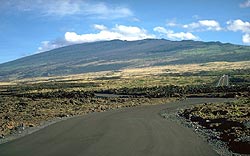
Hualalai Volcano on Hawaii
|
Variation diagram for both the tholeiitic shield and the alkaline post-shield rocks of Hualalai, on the NW coast of the island of Hawaii. (July, 2004)
Tholeiitic basalts have lower alumina and CaO and plot below the post shield alkali basalts. Note the gap between the alkali basalts and the trachytes which are the youngest of all. The group of rocks at 25% MgO with low Fe, Al, Ti are mafic inclusions. They should not be included but illustrate how mafic inclusions seldom lie along fractionation paths. A large number of wehrlites, dunites and westerites are present though not many analysed for ME.
The Zr/Nb varies from about 15 in the shield tholeiites down to 5-6 in the alkali-basalts and trachytes. Reported "dunites" with 33% alumina and <2% MgO have been excluded.
The bulk of the REE and metals have only been done for the alkaline series so some possible diagrams are not shown. |
 |
Ree diagram, mainly for alkaline series with La reaching almost 100 ppm. |
Kohala
 |
Variation diagram for Kohala Volcano, (now extinct) in N. Hawaii. Thesr post-shield rocks range from transitional to mildly alkaline and show strong fractionation from AOB to hawaiite, benmoreiite, but no real trachyte. |
 |
The alkaline earths show a sudden step in Ba which may coicide with the step in Zr/Nb below. Note that Nb = Y also indicating transitional rocks. |
 |
Zr/Nb. The transtional basalts have a Zr/Nb of 10 decreasing to 7 in the more alkaline ones. |
Kahoolawe
 |
Kahoolawe tholeiite to alkali basalts, Maui.
Note the spread of K and Rb; almost certainly due to tropical weathering. |
Maui Island
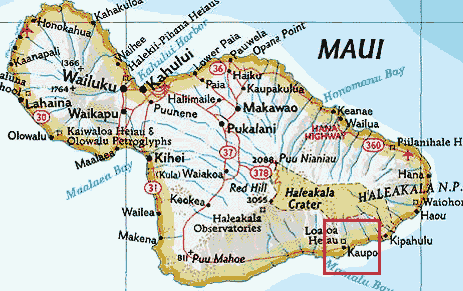 Maui is another large volcanic island about 70km long, being the next in the chain north-west of Hawaii. Kahoolawe is a small island lying SW of Maui along the line of the SW rift zone of East Maui. Maui is formed of two old shield volcanoes both dominated by rift zones as seen in Kilauea and Mauna Loa and separated by a median valley as seen in Oahu. Maui is another large volcanic island about 70km long, being the next in the chain north-west of Hawaii. Kahoolawe is a small island lying SW of Maui along the line of the SW rift zone of East Maui. Maui is formed of two old shield volcanoes both dominated by rift zones as seen in Kilauea and Mauna Loa and separated by a median valley as seen in Oahu.
West Maui is older and smaller with shield stage rocks of 2 – 1.3 myr. Post shield alkaline rocks are dated at 1.15 to 1.5 myr and a minor occurrence of Rejuvenation stage at ~ 0.36 – 0.6 myr BP.
East Maui (or Haleakala) has younger shield rocks of 800,000 yr, post-shield alkaline rocks of 930,000 – 300,000 yr BP. The long period that followed resulted in the deep weathering of the caldera where streams found an outlet to the coast. Within this eroded caldera are a series of recent Rejuvenation stage basanitic rocks, the youngest have erupted in 1790, so that Haleakala may not be entirely extinct.
 |
Variation diagram for tholeiites, AOB's and Basanites from Haleakala (East Maui.) Note the wide spread in Na and K especially. Cumulates are both picrite and ankaramite. |
 |
Zr/Nb for the Haleakala lavas showing progression in Nb enrichment from tholeiite to basanite-nephelinite.
Note that the Post Shield stage Kula Series are obviously composed of two different suites with Zr/Nb of ~ 6 and 8, though given the same name.
The yellow point at the base of the shield tholeiites is not assigned to any group though labelled "Tholeiite" and obviously belongs to the shield series. Two "Rejuvenation Stage" rocks must be misidentified.
The shield sage has Zr/Nb of 12 while the rejuvenated basanites-nephelinites average about 4.5. |
 |
Alkaline Earth elements. Note the Ba < Y in the tholeiites, increasing greatly in the basanites and nephelinites. Sr tends to form layers of increasing abundance. |
 |
Metals. The greatest variation is in V with wide variation in picrite - ankaramitte. Ni shows a moderate dispersion while Sc, Co and Zn show almost constant fractionation trends. |
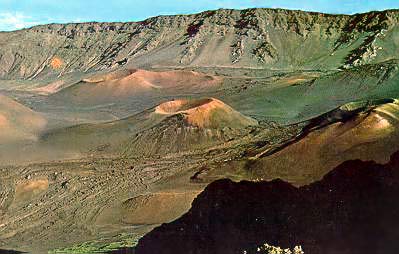
The erosion caldera of Haleakala on Maui showing in the distance the tholeiitic shield stage of the East Maui centre with the cinder cones of the recent Rejuvenation Stage in the foreground and middle distance.
|
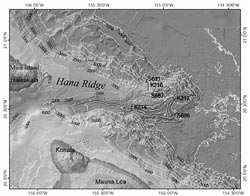
Bathmetric chart of the submerged Hana Ridge of East Maui. Sample sites recovered by submersible shown.
|
East Maui Submarine Hana Ridge
Click here to see abstract
 |
MgO vs Oxides.
A typical Hawaiian picrite series. |
 |
MgO vs metals |
 |
FM vs MgO
A spread at high Mg suggests differing olivine compositions, as found. |
 |
Zr vs Alkaline Earth Elements |
 |
Zr vs Nb The spread in Zr/Nb is rather similar to that seen in the Mauna Kea HSDP core. |
West Maui Volcano
This old and eroded cone is only some 3000ft ASL. The shield appear to be entirely built of tholeiitic basalt and picrites as in Mauna Kea and Kilauea. Only minimal data was available but recently Gaffney (2004, J.Pet. 45,(8),1663-1687) has presented data on 30 samples, some from a drill core, some from surface exposure, mainly of the shield stage but with two post shield alkaline rocks and a single sample of rejuvenation stage basanites.
Click here to see abstract.
| |__| |
The average Zr/Nb for the shield rocks is 12.5 decreasing to 10, but about 4 for the rejuvation stage sample. |
 |
Variation diagram for West Maui showing classic Hawaiian compositions. |
 |
The REE normalised against EMORB (=~ average oceanic crust)
Similar but not identical to Kilauea. |
 |
Normalised diagram for all residual elements but not on log scale. This shows more clearly the greater enrichment of the Rejuvenation Stage samples.(HO-36) One of the late-shield transitional samples appears to be enriched in REE only. The other is close to trachyte in composition while the rejuvenation stage sample is a basanite. Depletion in Cs, Rb is again probably due to weathering. |
 |
The same, on Log scale, note difference to Kilauea etc, mainly in Pb and P. Note also absence of plag-fractionation which would be shown by Eu and Sr. |
 |
The alkaline earth elements vs Zr. As in Puu Oo we have Sr > Zr > Ba > Y > Nb > Rb. The remarkable thing is that the rejuvenation stage sample, though enriched, has retained the same ratios with Sr > Zr > Ba etc. |
 |
West Maui - La vs REE |
Molokai
(This was the infamous leper colony island, where they sent any Chinese lepers to die.)
 |
Molokai.
Unlike the tholeiitic Lanai, all analysed samples from Molokai are alkaline series, from ankaramite to alkali basalt, hawaiite, mugearite. Virtually no Nb-Ta data available. |
 |
Molokai; Zr vs Alkaline Earth Elementsr
Note the Ba<Zr in the transitional-tholeittic members becoming Ba>Zr in the AOB's-Hawaiites-mugearite. Very few REE have been done for Molokai. |
 |
Minerals for Molokai done by EMP. Olivine shows an
an unusually wide range, the AOB being more iron rich. Note also
a subcalcic augrite. Only the most magnesian olivine plays any part
in fractionation. |
Xu, Frey etal, 2005(G-Cubed) have recently added
approx another 50 analysed rocks to the East Molokai files. They are similar
to those shown and while it is claimed Rejuvenated Stage rocks are present
they are a low degree of alkalinity. They will be added in a future update.
(June, 2005)
Lanai
 |
Lanai. (located off Molokai, between Maui and Oahu.)
A long extinct simple series of picrites with few unfractionated basalts and no alkaline members. With a Zr/Nb of an average of 14.7, Lanai is the most 'tholeiitic' of all Hawaiian centres. |
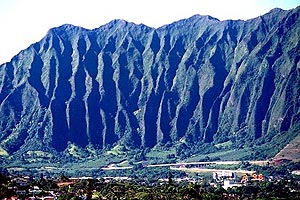 Here the Pali behind Kaneohe Bay rises steeply.
Here the Pali behind Kaneohe Bay rises steeply.
|
Oahu Id
The long extinct volcanoes of Oahu seem to have erupted along two parallel rift zones forming two mountain ranges. The Koolau Range which runs NW-SE on the NE side of the island is the more extensive. Tropical erosion of the massive basalts yields some strange landscape forms.
|
 |
Fingerpint of the basalts of the Koolau Shield Stage, (Frey, et al, 1994) Again the very low K and Rb are probably due to leaching. The general trend is more depleted than Kilauea, perhaps even more so than Mauna Loa. |
| Data from Oahu and Kauai are also altered being older. Similar types of tholeiite-picrite extend along a chain of submarine cones to Midway Island and then NNW to the Emperor Seamounts.
As Oahu includes shield stage rocks, post shield alkaline series, rejuvenation stage basanites-nephelinites and many wehrlite-harzburgite inclusions especially at the Salt Lake crater, and in addition there is considerable alteration in the older rocks, total diagrams are rather messy.
However, recently a new KSDP ( Koolau Scientify Drilling Project) drill hole has been cored deep in to Koolau range, and while some samples are marked as "strongly altered" the variations are not too bad, (Haskins & Garcia, 2004).
|
 |
Variation diagram for the Koolau drill core samples.
Again, a typical Hawaiian basalt picrite series. |
 |
Zr-group elements for Koolau. Again the standard pattern. A few of high Ba are not reflected in the Rb and are probably due to alteration.
The Zr/Nb (not shown, show some divergence from 13 - 16, ie more tholeiitic on average than Kilauea and close to Mauna Loa in composition.
REE diagrams for the Rejuvenation Stage nephelinites show them to be not greatly enriched in REE compared to basanites.
The Waianae range shows considerable alteration and so is not shown. |
Kauai Id
This island lies about 60 n.miles west north-west of Oahu.
 |
Fingerprint for Kauai. The rocks seem unusual being of high Mg, though no picrites are present, and very low silica and alkalies. They are termed nephelinites-basanites but are lower in alkalies than usual. K is certainly depleted by tropical weathering and other elements may be also. Otherwise the fingerprint is fairly typical Hawaiian. |
The Emperor Seamounts
Regelous etal, (2003, J.Pet.) have recently most kindly forwarded their data for both drilled and dredged samples from a series of the Emperor Seamounts. The ages increase steadily to the north to a maximum of 62myr. The composition of the different seamount groups varies but remains typically Hawaiian, some being rather more depleted than Mauna Loa, others enriched to the point of becoming transitional alkali basalts. The distances from the currently active Kilauea indicates that the Pacific plate has been moving steadily to the NW and N at an average rate of about 6 cm/yr.
As the bulk of the rock are not glasses and many are somewhat altered, the Rb,Ba,Th,U, K and Pb are somewhat erratic but the remaining elements are quite regular. Archaean ridge basalts show the same variations. Here we show the diagrams including elements which have alteration effects normalised to the Hawaiian standard rock BHVO. This allows immediate comparison with current compositions and shows which elements are the more reliable.
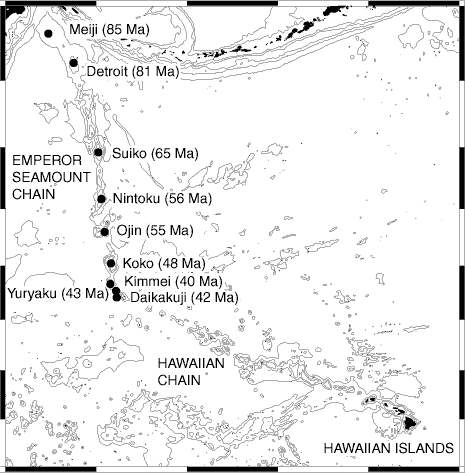
Click to contact the author:
Copyright © 1998-2006 Dr B.M.Gunn
BACK
|